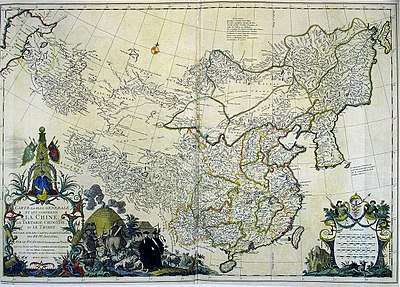Chinese Tartary
Chinese Tartary (see also Tartary) is an archaic geographical term used especially during the time of the Qing Dynasty. The term was used as early as 1734 on a map created by the French geographer and cartographer Jean Baptiste Bourguignon d’Anville (1697–1782) who published the map in the Nouvel atlas de la Chine, de la Tartarie Chinoise et du Thibet (New atlas of China, Chinese Tartary, and Tibet) in 1738 (refer to the date of 1734 that appears on the map).

D’Anville’s map was based on work ordered by the Emperor of China and conducted by Chinese under the supervision of the Jesuits.[1] Also published in 1738 was A description of the empire of China and Chinese-Tartary together with the kingdoms of Korea, and Tibet by Father Jean-Baptiste Du Halde.[2] He went on to write in 1741 The General History of China Containing a Geographical, Historical, Chronological, Political and Physical Description of the Empire of China, Chinese-Tartary, Corea and Thibet.[3]
Modern areas today that were described by their work as falling within Chinese Tartary included:
In 1832, its geographical boundaries are defined in A Geographical Dictionary Or Universal Gazetteer.[4]
By 1867, the areas of Chinese Tartary were described as the vast three areas covering Manchuria, Mongolia and Ili (Xinjiang).[5]
Further reading
- "Chinese Tartary." The Asiatic journal and monthly register for British and foreign India, China and Australasia, Volume 20. Allen, 1836. p. 292.
References
- "New atlas of China, Chinese Tartary, and Tibet". World Digital Library.
- A description of the empire of China and Chinese-Tartary together with the kingdoms of Korea, and Tibet by Jean-Baptiste Du Halde, Volume 2 (1738).
- {https://archive.org/details/generalhistoryc02haldgoog The General History of China: Containing a Geographical, Historical, Chronological, Political and Physical Description of the Empire of China, Chinese-Tartary, Corea and Thibet] by Jean-Baptiste Du Halde, Volume 2 (1736).
- Joseph Emerson Worcester (1832). "A Geographical Dictionary Or Universal Gazetteer, Ancient and Modern, Volume 2".
- Notes on Chinese Tartary by Captain Sherard Osborne R.N. C.B, Proceedings of the Royal Geographical Society of London Vol. 11, No. 4 (1866 - 1867), pp. 162-166